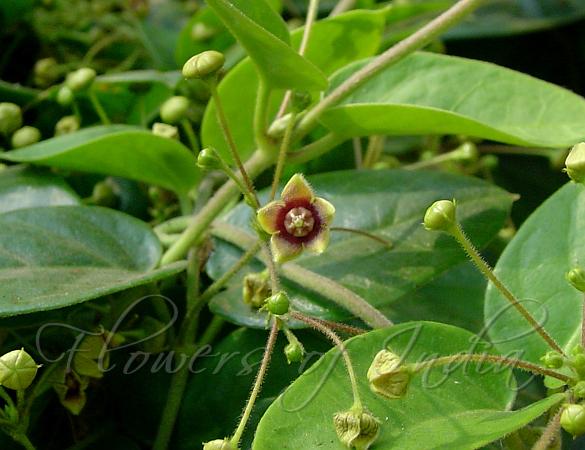|
| Indian Ipecac |
|

|

| File size | 431643 |
| Original date | |
| Resolution | 2048 x 1536 |
| Flash | Flash did not fire |
| Focal length | 6.3mm |
| Exposure time | 1/250s |
| Aperture | 4.0 |
| Focus Distance | |
| Metering Mode | Spot |
| Camera make | SONY |
| Camera model | DSC-P52 |
| Sensor type |
|
|
|
|
Photo: |
Botanical name: Vincetoxicum indicum Family: Apocynaceae (Oleander family)
Synonyms: Tylophora indica, Cynanchum indicum
Synonyms: Tylophora indica, Cynanchum indicum
Indian Ipecac is a small, slender, much branched,
velvety, twining or climbing herb with yellowish sap. It is mostly
found in the sub-himalayan tract from Uttarakhand to Meghalaya and in
the central and peninsular India. Rootstock is 2.5-5 cm, thick. Leaves,
6-11 cm long, 3.8-6 cm wide, are ovate-oblong to elliptic-oblong, with
a narrow tip, heart-shaped at base, thick, velvety beneath when young,
smooth above. Leaf stalks are up to 1.2 cm long. Flowers are small,
1-1.5 cm across, in 2 to 3-flowered fascicles in cymes in leaf axils.
Sepal tube is divided nearly to the base, densely hairy outside. Sepals
are lanceshaped. Flowers are greenish- yellow or greenish-purple, with
oblong pointy petals. Fruit is a follicle, up to 7 x 1 cm,
ovoid-lanceshaped. Flowering: August-December.
Medicinal uses: It is traditionally used as a
folk remedy in certain regions of India for the treatment of bronchial
asthma, inflammation, bronchitis, allergies, rheumatism and dermatitis.
It is traditionally used as a
folk remedy in certain regions of India for the treatment of bronchial
asthma, inflammation, bronchitis, allergies, rheumatism and dermatitis.
Medicinal uses:
 It is traditionally used as a
folk remedy in certain regions of India for the treatment of bronchial
asthma, inflammation, bronchitis, allergies, rheumatism and dermatitis.
It is traditionally used as a
folk remedy in certain regions of India for the treatment of bronchial
asthma, inflammation, bronchitis, allergies, rheumatism and dermatitis.
| Identification credit: Prashant Awale | Photographed in Mumbai & Agumbe, Karnataka.. |
• Is this flower misidentified? If yes,